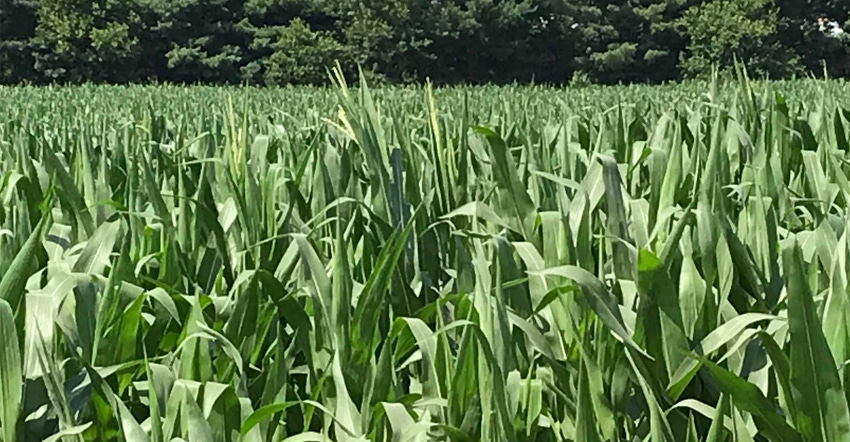July 18, 2019

With the cool start to the 2019 growing season, and the delayed and late planting, there are concerns about whether the corn crop will make it to physiological maturity or black layer stage before a killing frost occurs.
This is a concern especially for corn planted in June. A killing frost occurs when the temperature dips below 28 degrees F for several hours. If a killing frost occurs before corn reaches black layer, lower test weights and lower yields can be expected. A lower test weight may also impact the marketability of the crop.
Corn growth and development are driven by heat units, also called growing degree days. A certain number of GDDs, rather than calendar days, are needed for a corn plant to reach maturity or black layer. Seed companies will list the number of GDDs a hybrid requires to reach silking and black layer.
The number of GDDs it takes to reach silking and black layer relates back to a hybrid’s relative maturity. A higher relative maturity hybrid will require more GDDs to reach black layer, whereas a lower relative maturity hybrid will require fewer GDDs to reach black layer.
GDDs are calculated by averaging the daily high and low temperature, and then subtracting out the base temperature. The base temperature for corn is 50 degrees. There are two caveats with this formula. The first is if the daily high temperature exceeds 86 degrees, use 86 as the high temperature. The second caveat is if the low daily temperature falls below 50 degrees, then use 50 as the low daily temperature. The reasoning for this is that corn grows minimally above 86 degrees and does not grow below 50 degrees.
Adjusting GDDs for later planting
Corn adjusts to later planting by requiring fewer GDDs to reach maturity. Research conducted at Purdue University shows that when corn is planted after May 1, it matures in approximately 6.8 fewer GDDs per day delayed beyond May 1 (Nielsen et al., 2002).
For example, if a hybrid is rated as needing 2,600 accumulated GDDs from planting to physiological maturity and it was planted on May 31, that hybrid would only require 2,396 accumulated GDDs from planting to physiological maturity, or approximately 200 fewer GDDs.
What is the current GDD status? In April, May and the first part of June this year, we were slow to accumulate many GDDs. From May 1 to June 15, across the state of Iowa, we were running approximately 50 to 175 GDDs behind normal. With the heat that started the end of June and continued into the first part of July, it seemed like the crops finally took off and grew faster. However, most of the state was still averaging below normal in the number of accumulated GDDs.
Will we be able to catch up? The weather outlook can give us some indication on what to expect. The six- to 10-day and eight- to 14-day weather outlook as of the second week of July showed Iowa having above normal average temperatures. Warmer-than-normal temperatures will help to push the corn along; however, the one-month and 90-day outlooks show Iowa returning to having cooler-than-normal temperatures.
Tracking GDDs for your crop
One tool that farmers may find useful to help track their corn crop’s growth and development, and see if their crop will reach maturity prior to a killing frost is the U2U Corn GDD Decision Support Tool.
This online tool compiles weather data across the Midwest for a 30-year period to provide an estimate on when the corn crop may reach various stages like silking or reaching black layer, as well as when we typically expect to see the first killing frost.
One thing the tool does not adjust for is the ability of corn hybrids to mature in fewer GDDs when planted after May 1. If you planted after May 1, you will need to manually modify the “Black Layer GDDs” value in the tool’s input area. You can use this online calculator to adjust GDDs needed to reach back layer with later-planted corn. Note that if you adjust the number of GDDs required to reach black layer, the GDDs to reach silking may be off slightly in the model.
For example, there was a lot of corn planted the first week in June in the northern counties of northwest Iowa. Using the U2U GDD Tool with a June 5 planting date in Lyon County, Iowa and adjusting the GDDs needed for a 98-day maturity corn hybrid to reach black layer, the tool shows that with “average weather,” we should expect that corn to reach black layer before we typically would expect the average first frost to occur.
Note that if the GDDs are not adjusted for a 98-day corn hybrid to reach black layer for the later planting date of June 5, the tool shows that we should not expect the corn to reach maturity prior to a killing frost.
About the Author(s)
You May Also Like




